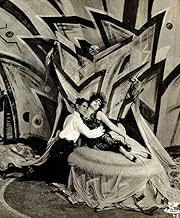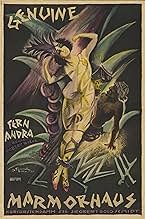Genuine
- 1920
- 1h 28min
CALIFICACIÓN DE IMDb
5.9/10
1.2 k
TU CALIFICACIÓN
Genuina es una divinidad antigua y cruel, que seduce a los hombres y los induce a matar como prueba de amor.Genuina es una divinidad antigua y cruel, que seduce a los hombres y los induce a matar como prueba de amor.Genuina es una divinidad antigua y cruel, que seduce a los hombres y los induce a matar como prueba de amor.
- Dirección
- Guionista
- Todo el elenco y el equipo
- Producción, taquilla y más en IMDbPro
Opiniones destacadas
For director Robert Wiene, he yearned to duplicate his success by hiring "Caligari's" writer, set designer & cinematographer for his next project, September 1920's "Genuine: The Tale of a Vampire." Using the same framing structure, the tale has a former painter falling asleep while reading a horror novel. His dream is about his portrait of a high priestess, Genuine, hanging on his wall above him. The dreamlike quality of the movie is similar to "Caligari" with its surreal sets and tone.
The term vampire in those days in cinema meant a woman taking the financial pants off of unsuspecting men. Such was the femme fatale Genuine, the subject of Wiene's film. Unfortunately for the director and Decia Studios, "Genuine" was a colossal flop. But that didn't stop him from directing well into the 1930's, producing some classics along the way.
The term vampire in those days in cinema meant a woman taking the financial pants off of unsuspecting men. Such was the femme fatale Genuine, the subject of Wiene's film. Unfortunately for the director and Decia Studios, "Genuine" was a colossal flop. But that didn't stop him from directing well into the 1930's, producing some classics along the way.
...yes, it's from the same director, Robert Wiene, whose landmark THE CABINET OF DR. CALIGARI was released earlier the very same year, 1920; and, yes, much of the same cinematic technique created for CALIGARI was used here as well. The main differences between the two utterly defeat any chance that GENUINE, at least in the 43-minute "condensation" that appears on the 2002 Kino DVD release, would ever be a tenth as watchable as CALIGARI (or, for that matter, THE HEARTS OF AGE, Orson Welles' self-described "amusement" that spoofed all the surrealist silent European cinema concocted by Wiene, F.W. Murnau, Salvador Dali and the like). First, the sets and makeup of the players are not as flamboyantly odd this time around. Second, the pacing is far too slow for the story. Third, the story is itself far too bizarre and convoluted for a casual viewer to find any interest in; CALIGARI's is relatively straightforward in comparison. If you want a pre-NOSFERATU take on vampires, track down the DVD of LES VAMPIRES instead...
Robert Wiene repeats the techniques he used in "The Cabinet of Dr. Caligari" with far less success in "Genuine". His looming architectures and broad swaths of darkness are glaringly at odds with the utterly ridiculous story of the seductress-priestess-wild girl brought to unsuspecting Europe. There are some striking visual effects, such as the jungle of branches where Genuine climbs up and up to escape from her prison, but they don't add up to anything. (I should note that only fragments, adding up to about a half hour, survive of this movie; but I suspect that the parts I didn't see wouldn't have added any deeper meaning.)
The same director, cinematographer and writer of "The Cabinet of Dr. Caligari" made this subsequent picture, "Genuine". Likewise, it is also an Expressionist film (one of the few made during Weimar Germany, contrary to what Lotte Eisner and the use by some of "expressionism" as an umbrella term for almost all German cinema of the period might suggest). Additionally, similar to "Caligari", the main body of "Genuine" is framed as a dream. Yet, I wasn't engulfed into the universe of it as I was with "Caligari".
The story, although just as peculiar, isn't as involving, which is unfortunately probably, in part, because the Kino release is only a condensed version. The framing of scenes is just as prosaic and theatrical as that in "Caligari"--if not more so. As well, the stylized acting seems more overdone and obtrusive this time. But, more importantly, the problem is the sets, which I can't see the entire version improving much upon. The Expressionist set designs are equally strange, with odd angels and geometric shapes. The production, however, leaves too much space open and unfilled, which is the largest reason that "Genuine" isn't as involving, or captivating, as "Caligari".
The story, although just as peculiar, isn't as involving, which is unfortunately probably, in part, because the Kino release is only a condensed version. The framing of scenes is just as prosaic and theatrical as that in "Caligari"--if not more so. As well, the stylized acting seems more overdone and obtrusive this time. But, more importantly, the problem is the sets, which I can't see the entire version improving much upon. The Expressionist set designs are equally strange, with odd angels and geometric shapes. The production, however, leaves too much space open and unfilled, which is the largest reason that "Genuine" isn't as involving, or captivating, as "Caligari".
I’ve been wanting to give this a whirl ever since acquiring it six years ago – as part of the Kino edition of the same director’s THE CABINET OF DR. CALIGARI (1920). However, the result (without taking into account its obvious narrative gaps, being incomplete in this version) is nowhere near as groundbreaking or even compelling as that earlier classic – despite the comparable Expressionist look (including a clock standing in for the face of a skeleton[!] and which is still its best quality).
The plot revolves around a femme fatale called Genuine – hence, the vampire of the title is not of the blood-sucking variety – who had actually been the high priestess of some cult. Due to a clash between factions, she ends up in a slave market (featuring surprising but discreet nudity) and is eventually bought by an eccentric old man (among other things, he likes to doze off while being shaved daily!), who keeps the girl in the cellar of his ‘notorious’ mansion so as to shelter her from the vices of modern life; incidentally, one is never quite sure in which era this is all supposed to be taking place – since the dapper but doddering old man has an Arab, with painted bare chest, for a servant! The irony, then, is that the girl’s own nature – she has a feral countenance and wears a skimpy striped outfit! – is infinitely more dangerous to the young men she enslaves (one of whom sports a highly anachronistic Duran Duran hairdo!). These, in fact, are somehow driven mad (as it stands, the details aren’t very clear – particularly with respect to the old man’s nephew); when the son of his exclusive barber is similarly afflicted, the latter rouses the populace against her and – in a scene which basically replicates Cesare the somnambulist’s fate from the aforementioned THE CABINET OF DR. CALIGARI – she dies in the ensuing pursuit.
In conclusion, the treatment afforded the film isn’t sufficiently gripping to rate it higher than a mere curio at this juncture; besides, it’s all the more disappointing coming from Wiene (who, besides CALIGARI also made the equally influential THE HANDS OF ORLAC [1924]). By the way, another interesting effort of his – the Dostoyevsky adaptation RASKOLNIKOV (1923) – will soon be released on DVD by the budget label Alpha (under the alternate title of CRIME AND PUNISHMENT)…
The plot revolves around a femme fatale called Genuine – hence, the vampire of the title is not of the blood-sucking variety – who had actually been the high priestess of some cult. Due to a clash between factions, she ends up in a slave market (featuring surprising but discreet nudity) and is eventually bought by an eccentric old man (among other things, he likes to doze off while being shaved daily!), who keeps the girl in the cellar of his ‘notorious’ mansion so as to shelter her from the vices of modern life; incidentally, one is never quite sure in which era this is all supposed to be taking place – since the dapper but doddering old man has an Arab, with painted bare chest, for a servant! The irony, then, is that the girl’s own nature – she has a feral countenance and wears a skimpy striped outfit! – is infinitely more dangerous to the young men she enslaves (one of whom sports a highly anachronistic Duran Duran hairdo!). These, in fact, are somehow driven mad (as it stands, the details aren’t very clear – particularly with respect to the old man’s nephew); when the son of his exclusive barber is similarly afflicted, the latter rouses the populace against her and – in a scene which basically replicates Cesare the somnambulist’s fate from the aforementioned THE CABINET OF DR. CALIGARI – she dies in the ensuing pursuit.
In conclusion, the treatment afforded the film isn’t sufficiently gripping to rate it higher than a mere curio at this juncture; besides, it’s all the more disappointing coming from Wiene (who, besides CALIGARI also made the equally influential THE HANDS OF ORLAC [1924]). By the way, another interesting effort of his – the Dostoyevsky adaptation RASKOLNIKOV (1923) – will soon be released on DVD by the budget label Alpha (under the alternate title of CRIME AND PUNISHMENT)…
¿Sabías que…?
- TriviaA 43-minute condensation of this silent film can be found as an Extra Feature on the Kino Video DVD of El gabinete del Dr. Caligari (1920). A full-length version is stored at the Munich City Film Museum archive in Germany. A VHS transfer of a full length version (with French intertitles) exists. A copy can be found on YouTube.
- Citas
Percy Melo: Dead! She is dead!
- ConexionesEdited into Histoire(s) du cinéma: Une histoire seule (1989)
Selecciones populares
Inicia sesión para calificar y agrega a la lista de videos para obtener recomendaciones personalizadas
Detalles
- Fecha de lanzamiento
- País de origen
- Idiomas
- También se conoce como
- Genuine: The Tragedy of a Vampire
- Locaciones de filmación
- Productora
- Ver más créditos de la compañía en IMDbPro
- Tiempo de ejecución
- 1h 28min(88 min)
- Color
- Mezcla de sonido
- Relación de aspecto
- 1.33 : 1
Contribuir a esta página
Sugiere una edición o agrega el contenido que falta





















